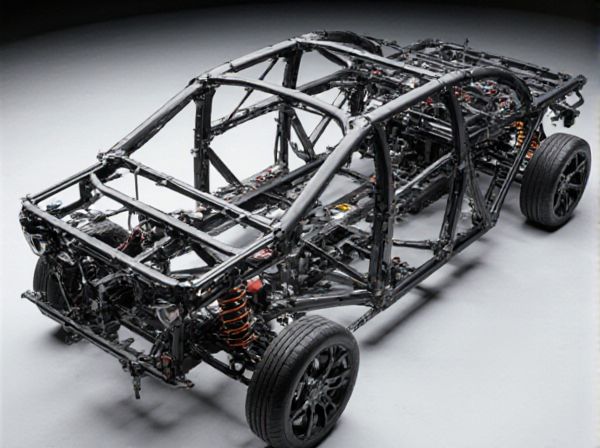
Photo illustration: Space Frame vs Ladder Frame
Space frames offer superior rigidity and weight distribution due to their geometric design, making them ideal for high-performance vehicles requiring enhanced handling and safety. Ladder frames are heavier and simpler, providing excellent strength for off-road and heavy-duty applications but lacking the torsional stiffness of space frames. Your choice depends on whether you prioritize lightweight agility or rugged durability in your vehicle's chassis.
Table of Comparison
| Feature | Space Frame | Ladder Frame |
|---|---|---|
| Structure | Network of interconnected tubes forming a rigid skeleton | Two parallel longitudinal rails linked by cross members |
| Weight | Lightweight due to tubular design | Heavier, uses thick steel beams |
| Strength | High torsional rigidity and impact resistance | Strong in bending but less torsional stiffness |
| Application | Sports cars, racing vehicles, high-performance cars | Trucks, SUVs, off-road vehicles, heavy-duty cars |
| Manufacturing Complexity | Complex welding and precise engineering required | Simple construction and easier mass production |
| Cost | Higher due to intricate design and materials | Lower, uses conventional materials and methods |
| Repairability | More difficult to repair due to integrated structure | Easier to repair or modify individual sections |
Introduction to Space Frame and Ladder Frame
Space frames are lightweight, triangulated structures composed of interconnected struts forming a rigid framework, commonly used in automotive chassis and architectural designs for enhanced strength-to-weight ratio. Ladder frames, featuring two longitudinal beams connected by several cross members, provide a robust and straightforward platform traditionally employed in trucks and off-road vehicles due to their durability and ease of repair. Understanding the structural differences between space frames and ladder frames is crucial for selecting the appropriate chassis design based on performance, weight, and application requirements.
Structural Overview: Space Frame Explained
Space frames are lightweight, three-dimensional truss structures composed of interconnected struts arranged in geometric patterns, providing exceptional rigidity and strength. Unlike ladder frames, which rely on two parallel beams connected by crossmembers, space frames distribute loads evenly across multiple points, minimizing stress concentrations and enhancing torsional stiffness. This structural efficiency makes space frames ideal for high-performance vehicles and architectural applications requiring optimized strength-to-weight ratios.
Structural Overview: Ladder Frame Explained
The ladder frame consists of two longitudinal beams connected by several lateral cross members, forming a rigid, rectangular structure that supports heavy loads and enhances vehicle durability. Commonly used in trucks and SUVs, its design offers excellent torsional strength and ease of repair, making it ideal for off-road and utility applications. This frame type provides a stable base but typically results in a heavier chassis compared to modern unibody or space frame structures.
Strength and Rigidity Comparison
Space frames offer superior strength and rigidity due to their triangulated structure, which distributes loads evenly across multiple members, reducing stress concentrations. Ladder frames, while robust and capable of handling heavy loads, exhibit less torsional stiffness because their design relies on two parallel beams connected by cross-members, leading to more flex under twisting forces. Engineers often prefer space frames in high-performance applications where maximum rigidity and weight savings are critical, whereas ladder frames remain popular in trucks and off-road vehicles for their durability and ease of repair.
Weight and Material Efficiency
Space frames utilize a network of interconnected struts, distributing loads efficiently and reducing overall structural weight compared to ladder frames, which rely on heavy, solid beams. The triangulated design of space frames allows the use of lighter materials such as aluminum alloys and high-strength steel, enhancing material efficiency and improving weight-to-strength ratios. Ladder frames, often made from thicker steel sections, provide robustness but result in higher vehicle weight and less optimized material use.
Manufacturing Complexity and Cost
Space frames involve intricate welding and precise assembly of multiple tubular components, resulting in higher manufacturing complexity and increased labor costs. Ladder frames use simpler, straight steel rails, making fabrication less complex and more cost-effective for mass production. The advanced design of space frames enhances vehicle rigidity but demands greater investment in specialized tooling and skilled labor compared to the straightforward construction of ladder frames.
Application in Automotive and Aerospace Industries
Space frames offer superior torsional rigidity and lightweight properties, making them ideal for high-performance automotive sports cars and lightweight aerospace structures where strength-to-weight ratio is critical. Ladder frames, characterized by simplicity and robustness, are predominantly used in heavy-duty vehicles like trucks and off-road vehicles due to their durability and ease of repair. Aerospace applications favor space frame designs for aircraft fuselages and satellite structures to optimize fuel efficiency and payload capacity.
Safety and Crashworthiness Analysis
Space frames offer superior crashworthiness due to their interconnected tubular structure, which distributes impact forces more evenly and reduces occupant injury risk. Ladder frames, while robust for heavy loads, tend to concentrate crash forces along the longitudinal rails, increasing potential deformation and compromising passenger safety. Advanced simulations highlight that the intrinsic rigidity of space frames enhances energy absorption and structural integrity during collisions compared to conventional ladder frames.
Maintenance, Repair, and Longevity
Space frames offer superior durability and easier access for maintenance due to their integrated design, reducing repair time and costs compared to ladder frames. Ladder frames, with their simpler construction, typically require more frequent inspections and are prone to rust and structural fatigue, resulting in higher long-term maintenance expenses. The longevity of space frames often surpasses ladder frames, especially in high-stress or off-road conditions, due to enhanced rigidity and corrosion resistance.
Choosing the Right Frame: Key Considerations
Choosing the right frame between space frame and ladder frame depends on vehicle application, weight distribution, and structural rigidity requirements. Space frames, known for their lightweight yet strong tubular construction, are ideal for sports cars and high-performance vehicles seeking superior handling and torsional stiffness. Ladder frames offer durability and simplicity, making them suitable for trucks and off-road vehicles that prioritize load-bearing capacity and ease of repair.
 caratoz.com
caratoz.com